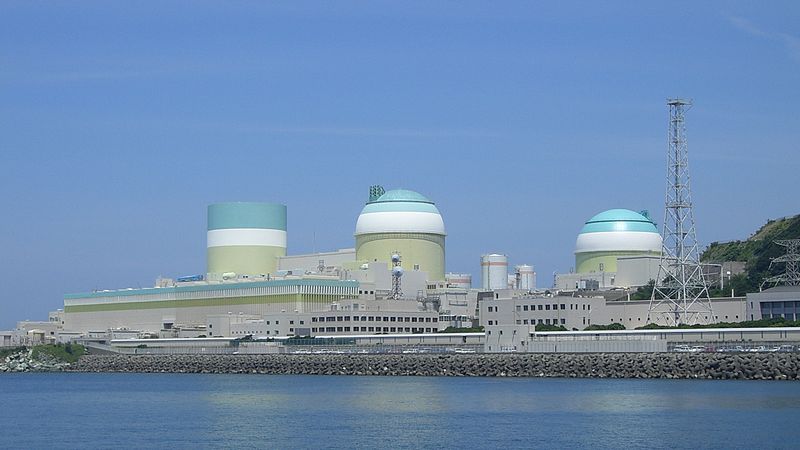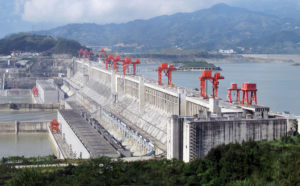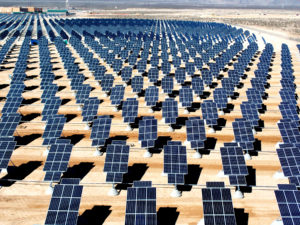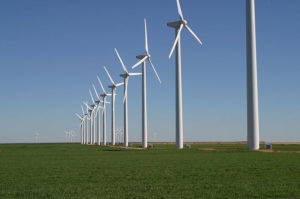What is Power Plant ?
A power station, also referred to as a generating station, power plant, powerhouse, or generating plant, is an industrial facility for the generation of electric power. Most power stations contain one or more generators, a rotating machine that converts mechanical power into electrical power. The relative motion between a magnetic field and a conductor creates an electrical current. The energy source harnessed to turn the generator varies widely. Most power stations in the world burn fossil fuels such as coal,oil, and natural gas to generate electricity. Others use nuclear power, but there is an increasing use of cleaner renewable sourcessuch as solar, wind, wave and hydroelectric.
• Fossil-fuel power stations may also use a steam turbine generator or in the case of natural gas-fired plants may use a combustion turbine. A coal-fired power station produces heat by burning coal in a steam boiler. The steam drives a steam turbine and generator that then produces electricity. The waste products of combustion include ash, sulphur dioxide, nitrogen oxides and carbon dioxide. Some of the gases can be removed from the waste stream to reduce pollution.
• Nuclear power plants use a nuclear reactor’s heat that is transferred to steam which then operates a steam turbine and generator. About 20 percent of electric generation in the USA is produced by nuclear power plants.
• Geothermal power plants use steam extracted from hot underground rocks. These rocks are heated by the decay of radioactive material in the Earth’s crust.
• Biomass-fuelled power plants may be fuelled by waste from sugar cane, municipal solid waste, landfill methane, or other forms of biomass.
• In integrated steel mills, blast furnace exhaust gas is a low-cost, although low-energy-density, fuel.
• Waste heat from industrial processes is occasionally concentrated enough to use for power generation, usually in a steam boiler and turbine.
• Solar thermal electric plants use sunlight to boil water and produce steam which turns the generator.

Fig: Ikata Nuclear Powerplant,Japan
By prime mover:
• Steam turbine plants use the dynamic pressure generated by expanding steam to turn the blades of a turbine. Almost all large non-hydro plants use this system. About 90 percent of all electric power produced in the world is through use of steam turbines.[6]
• Gas turbine plants use the dynamic pressure from flowing gases (air and combustion products) to directly operate the turbine. Natural-gas fuelled (and oil fueled) combustion turbine plants can start rapidly and so are used to supply “peak” energy during periods of high demand, though at higher cost than base-loaded plants. These may be comparatively small units, and sometimes completely unmanned, being remotely operated. This type was pioneered by the UK, Princetown[7] being the world’s first, commissioned in 1959.
• Combined cycle plants have both a gas turbine fired by natural gas, and a steam boiler and steam turbine which use the hot exhaust gas from the gas turbine to produce electricity. This greatly increases the overall efficiency of the plant, and many new baseload power plants are combined cycle plants fired by natural gas.
• Internal combustion reciprocating engines are used to provide power for isolated communities and are frequently used for small cogeneration plants. Hospitals, office buildings, industrial plants, and other critical facilities also use them to provide backup power in case of a power outage. These are usually fuelled by diesel oil, heavy oil, natural gas, and landfill gas.
• Microturbines, Stirling engine and internal combustion reciprocating engines are low-cost solutions for using opportunity fuels, such as landfill gas, digester gas from water treatment plants and waste gas from oil production.
Power plants that can be dispatched (scheduled) to provide energy to a system include:
• Base load power plants run nearly continually to provide that component of system load that doesn’t vary during a day or week. Baseload plants can be highly optimized for low fuel cost, but may not start or stop quickly during changes in system load. Examples of base-load plants would include large modern coal-fired and nuclear generating stations, or hydro plants with a predictable supply of water.
• Peaking power plants meet the daily peak load, which may only be for one or two hours each day. While their incremental operating cost is always higher than base load plants, they are required to ensure security of the system during load peaks. Peaking plants include simple cycle gas turbines and sometimes reciprocating internal combustion engines, which can be started up rapidly when system peaks are predicted. Hydroelectric plants may also be designed for peaking use.
• Load following power plants can economically follow the variations in the daily and weekly load, at lower cost than peaking plants and with more flexibility than baseload plants.
Non-dispatchable plants include such sources as wind and solar energy; while their long-term contribution to system energy supply is predictable, on a short-term (daily or hourly) base their energy must be used as available since generation cannot be deferred. Contractual arrangements (“take or pay”) with independent power producers or system interconnections to other networks may be effectively non-dispatchable.
Cooling Tower:
All thermal power plants produce waste heat energy as a byproduct of the useful electrical energy produced. The amount of waste heat energy equals or exceeds the amount of energy converted into useful electricity. Gas-fired power plants can achieve as much as 65 percent conversion efficiency, while coal and oil plants achieve around 30 to 49 percent. The waste heat produces a temperature rise in the atmosphere, which is small compared to that produced by greenhouse-gas emissions from the same power plant. Natural draft wetcooling towers at many nuclear power plants and large fossil fuel-fired power plants use large hyperboloid chimney-like structures (as seen in the image at the right) that release the waste heat to the ambient atmosphere by the evaporation of water.
However, the mechanical induced-draft or forced-draft wet cooling towers in many large thermal power plants, nuclear power plants, fossil-fired power plants, petroleum refineries, petrochemical plants, geothermal, biomass and waste-to-energy plants use fans to provide air movement upward through downcoming water, and are not hyperboloid chimney-like structures. The induced or forced-draft cooling towers are typically rectangular, box-like structures filled with a material that enhances the mixing of the up flowing air and the down flowing water.
Power from renewable energy:
Power stations can also generate electrical energy from renewable energy sources.
In a hydroelectric power station water flows though turbines using hydropower to generate hydroelectricity. Power is captured from the gravitational force of water falling through penstocks to water turbines connected to generators. The amount of power available is a combination of height and flow. A wide range of Dams may be built to raise the water level, and create a lake for storing water. Hydropower is produced in 150 countries, with the Asia-Pacific region generating 32 percent of global hydropower in 2010. China is the largest hydroelectricity producer, with 721 terawatt-hours of production in 2010, representing around 17 percent of domestic electricity use.
captured from the gravitational force of water falling through penstocks to water turbines connected to generators. The amount of power available is a combination of height and flow. A wide range of Dams may be built to raise the water level, and create a lake for storing water. Hydropower is produced in 150 countries, with the Asia-Pacific region generating 32 percent of global hydropower in 2010. China is the largest hydroelectricity producer, with 721 terawatt-hours of production in 2010, representing around 17 percent of domestic electricity use.
Solar energy can be turned into electricity either directly in solar cells, or in a concentrating solar power plant by focusing the light to run a heat engine.

A solar photovoltaic power plant converts sunlight into direct current electricity using the photoelectric effect. Inverters change the direct current into alternating current for connection to the electrical grid. This type of plant does not use rotating machines for energy conversion.
Solar thermal power plants are another type of solar power plant. They use either parabolic troughs or heliostats to direct sunlight onto a pipe containing a heat transfer fluid, such as oil. The heated oil is then used to boil water into steam, which turns a turbine that drives an electrical generator. The central tower type of solar thermal power plant uses hundreds or thousands of mirrors, depending on size, to direct sunlight onto a receiver on top of a tower. Again, the heat is used to produce steam to turn turbines that drive electrical generators.
Wind:
Wind turbines can be used to generate electricity in areas with strong, steady winds, sometimes offshore. Many

different designs have been used in the past, but almost all modern turbines being produced today use a three-bladed, upwind design. Grid-connected wind turbines now being built are much larger than the units installed during the 1970s. They thus produce power more cheaply and reliably than earlier models. With larger turbines (on the order of one megawatt), the blades move more slowly than older, smaller, units, which makes them less visually distracting and safer for birds.
Others Three Types: